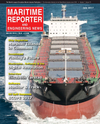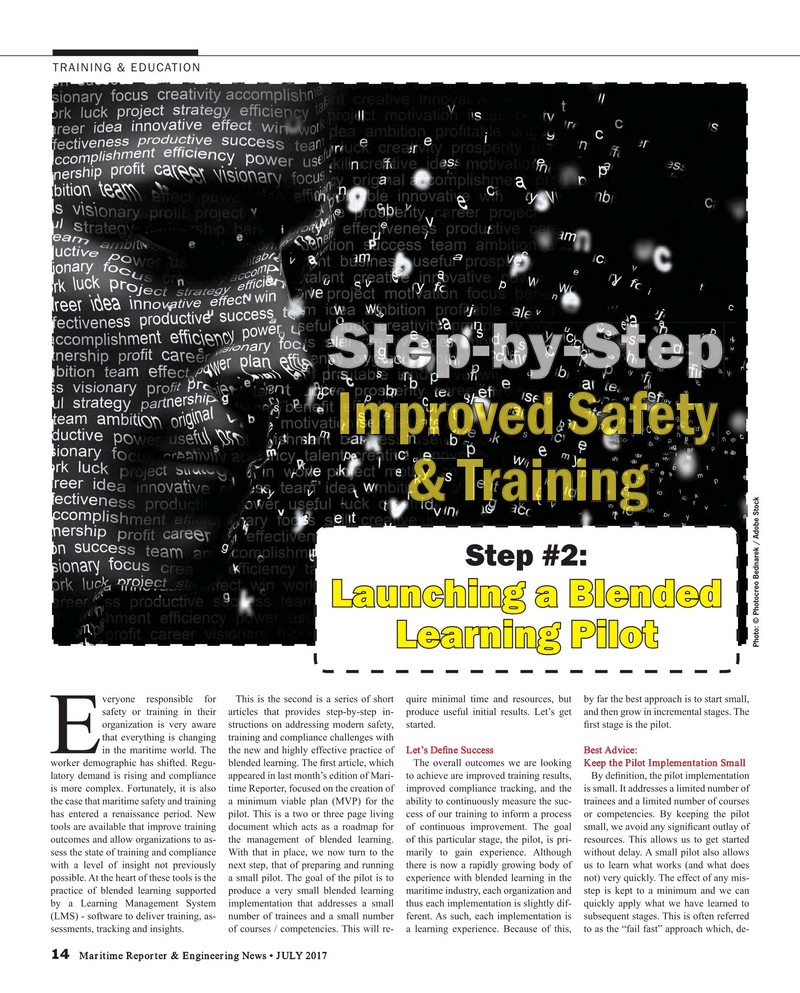
Page 14: of Maritime Reporter Magazine (July 2017)
The Marine Communications Edition
Read this page in Pdf, Flash or Html5 edition of July 2017 Maritime Reporter Magazine
TRAINING & EDUCATION
Step #2:
Launching a Blended Launching a Blended
Photo: © Photocreo Bednarek / Adobe Stock
Learning PilotLearning Pilot veryone responsible for This is the second is a series of short quire minimal time and resources, but by far the best approach is to start small, safety or training in their articles that provides step-by-step in- produce useful initial results. Let’s get and then grow in incremental stages. The organization is very aware structions on addressing modern safety, started. ? rst stage is the pilot. that everything is changing training and compliance challenges with in the maritime world. The the new and highly effective practice of Let’s De? ne Success Best Advice:
E worker demographic has shifted. Regu- blended learning. The ? rst article, which The overall outcomes we are looking Keep the Pilot Implementation Small latory demand is rising and compliance appeared in last month’s edition of Mari- to achieve are improved training results, By de? nition, the pilot implementation is more complex. Fortunately, it is also time Reporter, focused on the creation of improved compliance tracking, and the is small. It addresses a limited number of the case that maritime safety and training a minimum viable plan (MVP) for the ability to continuously measure the suc- trainees and a limited number of courses has entered a renaissance period. New pilot. This is a two or three page living cess of our training to inform a process or competencies. By keeping the pilot tools are available that improve training document which acts as a roadmap for of continuous improvement. The goal small, we avoid any signi? cant outlay of outcomes and allow organizations to as- the management of blended learning. of this particular stage, the pilot, is pri- resources. This allows us to get started sess the state of training and compliance With that in place, we now turn to the marily to gain experience. Although without delay. A small pilot also allows with a level of insight not previously next step, that of preparing and running there is now a rapidly growing body of us to learn what works (and what does possible. At the heart of these tools is the a small pilot. The goal of the pilot is to experience with blended learning in the not) very quickly. The effect of any mis- practice of blended learning supported produce a very small blended learning maritime industry, each organization and step is kept to a minimum and we can by a Learning Management System implementation that addresses a small thus each implementation is slightly dif- quickly apply what we have learned to (LMS) - software to deliver training, as- number of trainees and a small number ferent. As such, each implementation is subsequent stages. This is often referred sessments, tracking and insights. of courses / competencies. This will re- a learning experience. Because of this, to as the “fail fast” approach which, de- 14 Maritime Reporter & Engineering News • JULY 2017
MR #7 (10-17).indd 14 MR #7 (10-17).indd 14 7/6/2017 10:58:21 AM7/6/2017 10:58:21 AM

 13
13

 15
15
